spring对于java程序员来说,重要性不可言喻,可以想象下如果没有他,我们要多做多少工作,下面一个系列来介绍下spring(5.x版本)。
spring模块
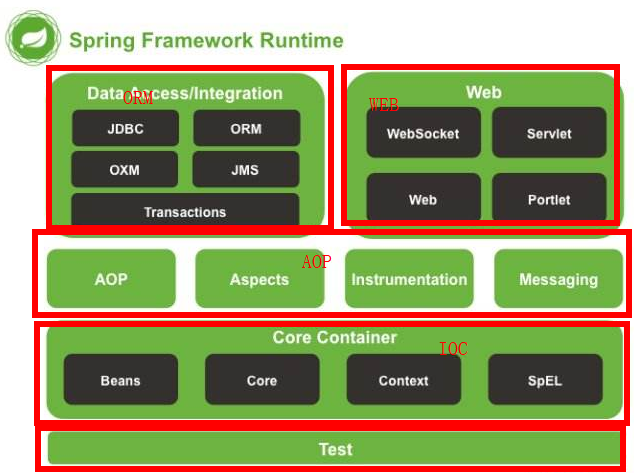
IOC概念
spring中最重要的两个部分就是ioc和aop,先来介绍ioc。ioc也叫控制反转,其实说白了,就是容器帮你去创建对象(前提是你交给对象管理),并且创造出的对象默认是单例的,也可以非单例,并且自动帮你实现注入功能,很屌。
项目demo
先来建个demo项目,本人使用的是idea,新建maven项目,
1、设置编码
为了防止项目中出现乱码,统一使用utf-8编码格式。
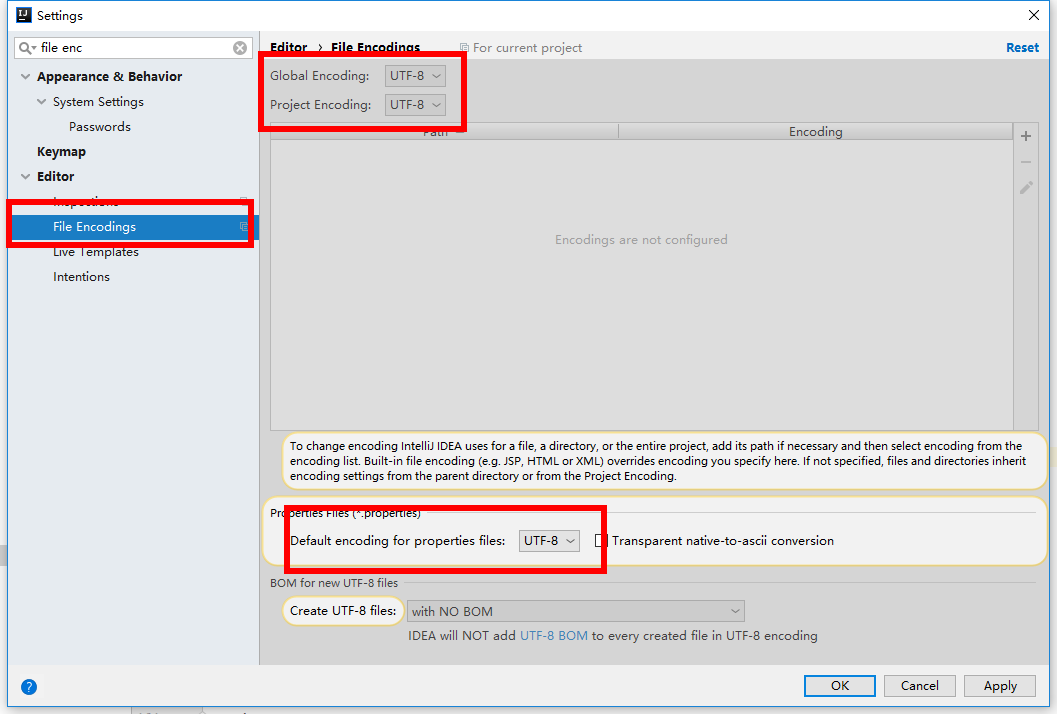
2、idea中设置maven
首先在maven的setting.xml配置maven镜像,在mirrors节点下配置阿里云镜像,国内的下载速度快
<mirrors> <!-- mirror | Specifies a repository mirror site to use instead of a given repository. The repository that | this mirror serves has an ID that matches the mirrorOf element of this mirror. IDs are used | for inheritance and direct lookup purposes, and must be unique across the set of mirrors. | <mirror> <id>mirrorId</id> <mirrorOf>repositoryId</mirrorOf> <name>Human Readable Name for this Mirror.</name> <url>http://my.repository.com/repo/path</url> </mirror> --> <mirror> <id>nexus-aliyun</id> <mirrorOf>*</mirrorOf> <name>Nexus aliyun</name> <url>http://maven.aliyun.com/nexus/content/groups/public</url> </mirror> </mirrors>
然后在idea中将maven的设置改成自己本地,不然会取默认的配置。
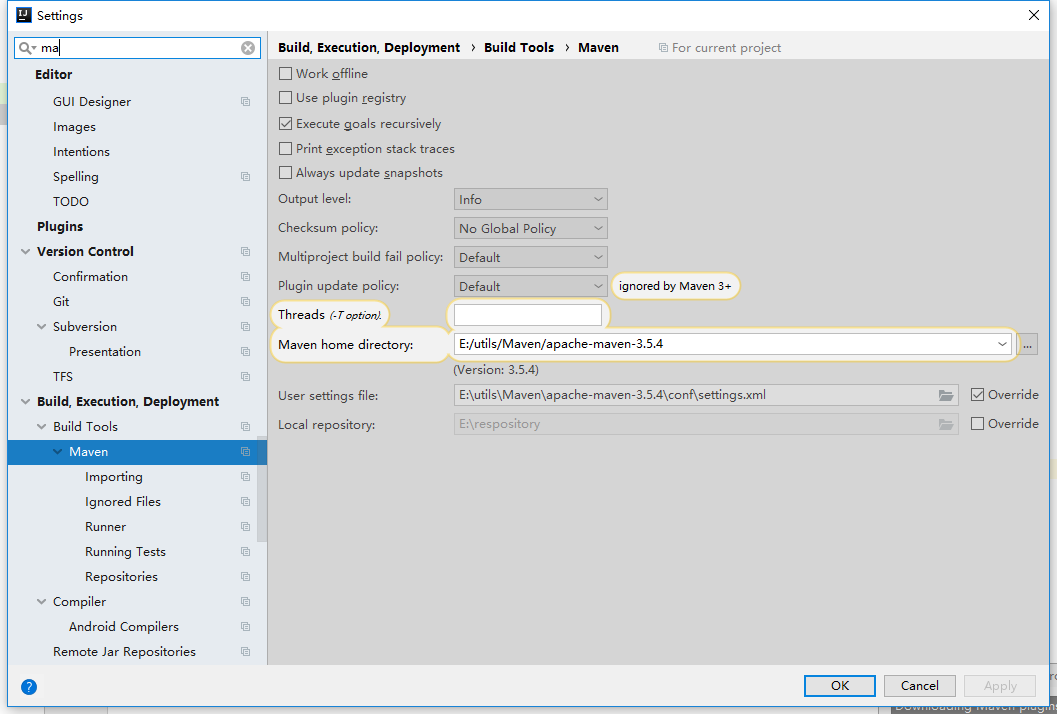
3、新建maven项目

4、添加依赖等。pom.xml如下:
<?xml version="1.0" encoding="UTF-8"?> <project xmlns="http://maven.apache.org/POM/4.0.0" xmlns:xsi="http://www.w3.org/2001/XMLSchema-instance" xsi:schemaLocation="http://maven.apache.org/POM/4.0.0 http://maven.apache.org/xsd/maven-4.0.0.xsd"> <modelVersion>4.0.0</modelVersion> <groupId>com.ty</groupId> <artifactId>SpringStudy</artifactId> <version>1.0-SNAPSHOT</version> <name>spring4.x study</name> <description>it's only for studying</description> <dependencies> <dependency> <groupId>org.springframework</groupId> <artifactId>spring-core</artifactId> <version>5.1.6.RELEASE</version> </dependency> <dependency> <groupId>org.springframework</groupId> <artifactId>spring-beans</artifactId> <version>5.1.6.RELEASE</version> </dependency> <dependency> <groupId>javax.servlet</groupId> <artifactId>javax.servlet-api</artifactId> <version>4.0.1</version> <scope>provided</scope> </dependency> <dependency> <groupId>javax.servlet</groupId> <artifactId>jstl</artifactId> <version>1.2</version> </dependency> </dependencies> </project>
5、新建两个类
package com.ty.beans; public class School { private String address; private Student student; public School(Student student) { this.student = student; } }
package com.ty.beans; public class Student { private int age; private String name; public int getAge() { return age; } public void setAge(int age) { this.age = age; } public String getName() { return name; } public void setName(String name) { this.name = name; } }
applicationContext.xml文件:
<?xml version="1.0" encoding="UTF-8"?> <beans xmlns="http://www.springframework.org/schema/beans" xmlns:xsi="http://www.w3.org/2001/XMLSchema-instance" xsi:schemaLocation="http://www.springframework.org/schema/beans http://www.springframework.org/schema/beans/spring-beans.xsd"> <bean id="student" class="com.ty.beans.Student"> <!-- property代表的是set方法注入--> <property name="age" value="27"></property> <property name="name" value="马云"></property> </bean> <bean id="school" class="com.ty.beans.School"> <!-- constructor代表的是构造器注入--> <constructor-arg ref="student"></constructor-arg> </bean> </beans>
测试类:
package com.ty.beans; import javafx.application.Application; import org.junit.Test; import org.junit.runner.RunWith; import org.springframework.beans.factory.BeanFactory; import org.springframework.beans.factory.xml.XmlBeanFactory; import org.springframework.context.ApplicationContext; import org.springframework.context.support.ClassPathXmlApplicationContext; import org.springframework.test.context.ContextConfiguration; import org.springframework.test.context.junit4.AbstractJUnit4SpringContextTests; import org.springframework.test.context.junit4.SpringJUnit4ClassRunner; @ContextConfiguration(locations = { "classpath:applicationContext.xml" }) @RunWith(SpringJUnit4ClassRunner.class) public class IOCTest { @Test public void testIOC() { ApplicationContext context = new ClassPathXmlApplicationContext("classpath:applicationContext.xml"); System.out.println(context.getBean("student")); System.out.println(context.getBean("school")); } }
运行结果:
com.ty.beans.Student@65d6b83b
com.ty.beans.School@d706f19
那么为啥spring可以做到这点呢?往下看:
相关java基础回顾
本人在说jvm模块的类加载的时候,说到class文件流经过验证后进入方法区,并且会创建一个class对象,而java中的反射可以使用class对象进行操作,如构造函数、属性和方法等等。
1、反射
package com.ty.reflect; public class Car { private String brand; private String color; private int maxSpeed; public Car() { } public Car(String brand, String color, int maxSpeed) { this.brand = brand; this.color = color; this.maxSpeed = maxSpeed; } public void introduce() { System.out.println("This is a test" + ";汽车品牌为" + this.getBrand()); } public String getBrand() { return brand; } public void setBrand(String brand) { this.brand = brand; } public String getColor() { return color; } public void setColor(String color) { this.color = color; } public int getMaxSpeed() { return maxSpeed; } public void setMaxSpeed(int maxSpeed) { this.maxSpeed = maxSpeed; } }
package com.ty.reflect; import java.lang.reflect.Constructor; import java.lang.reflect.Method; public class ReflectTest { public static Car init() throws Throwable { Class clazz = Car.class; //获取car的无参构造器 Constructor<?> cons = clazz.getDeclaredConstructor(); //通过无参构造器实例化对象 Car car = (Car) cons.newInstance(); Method setBrand = clazz.getMethod("setBrand", String.class); //实例方法的第一个隐式参数就是当前对象this setBrand.invoke(car, "大众"); return car; } public static void main(String[] args) throws Throwable { Car car = init(); car.introduce(); } }
运行结果:
This is a test;汽车品牌为大众
注:如果某个类中存在private属性或是方法,反射可以直接访问,因此反射也从一定程度上打破了封装。
field.setAccessible(true); method.setAccessible(true);
2、ClassLoader方法
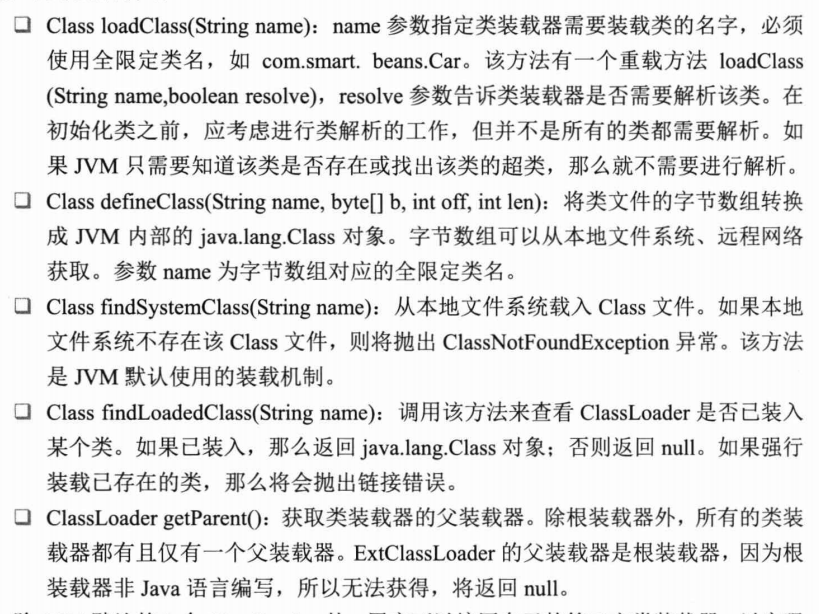

BeanFactory
一般将BeanFactory称为ioc容器,将ApplicationContext称为应用上下文。

ApplicationContext
1、ApplicationContext

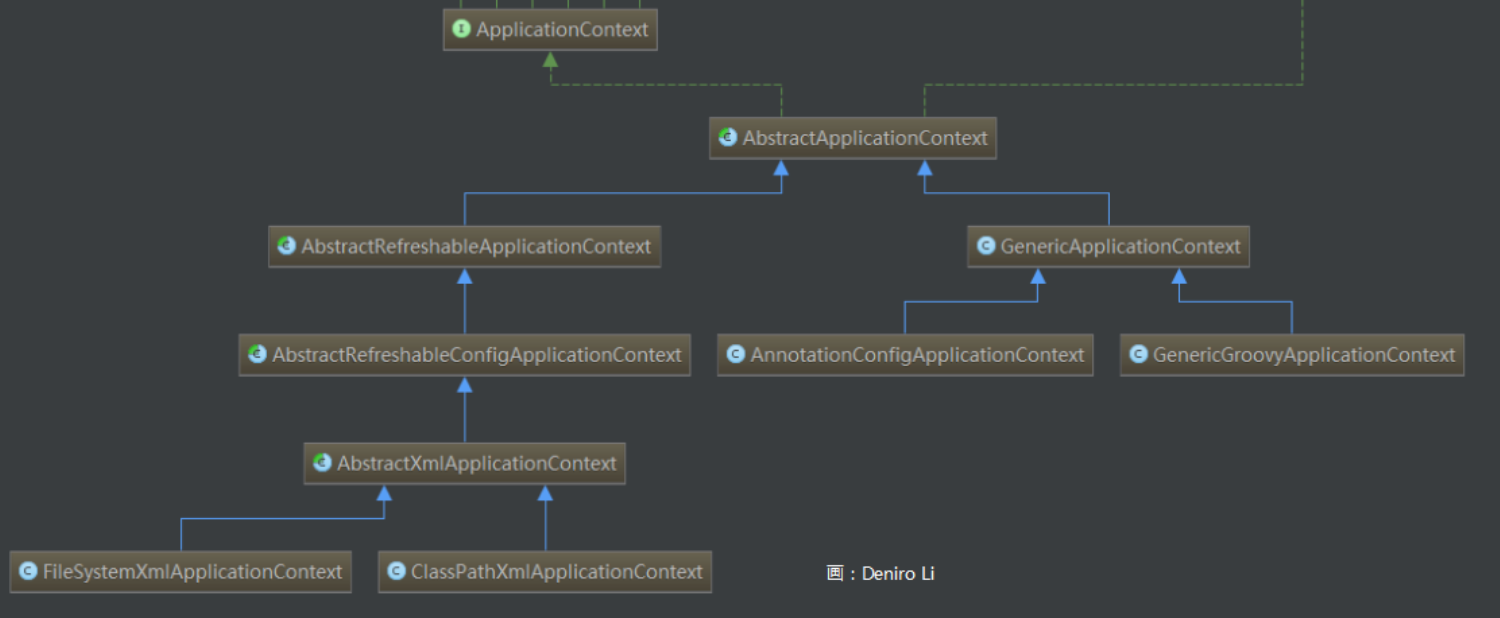
2、WebApplicationContext
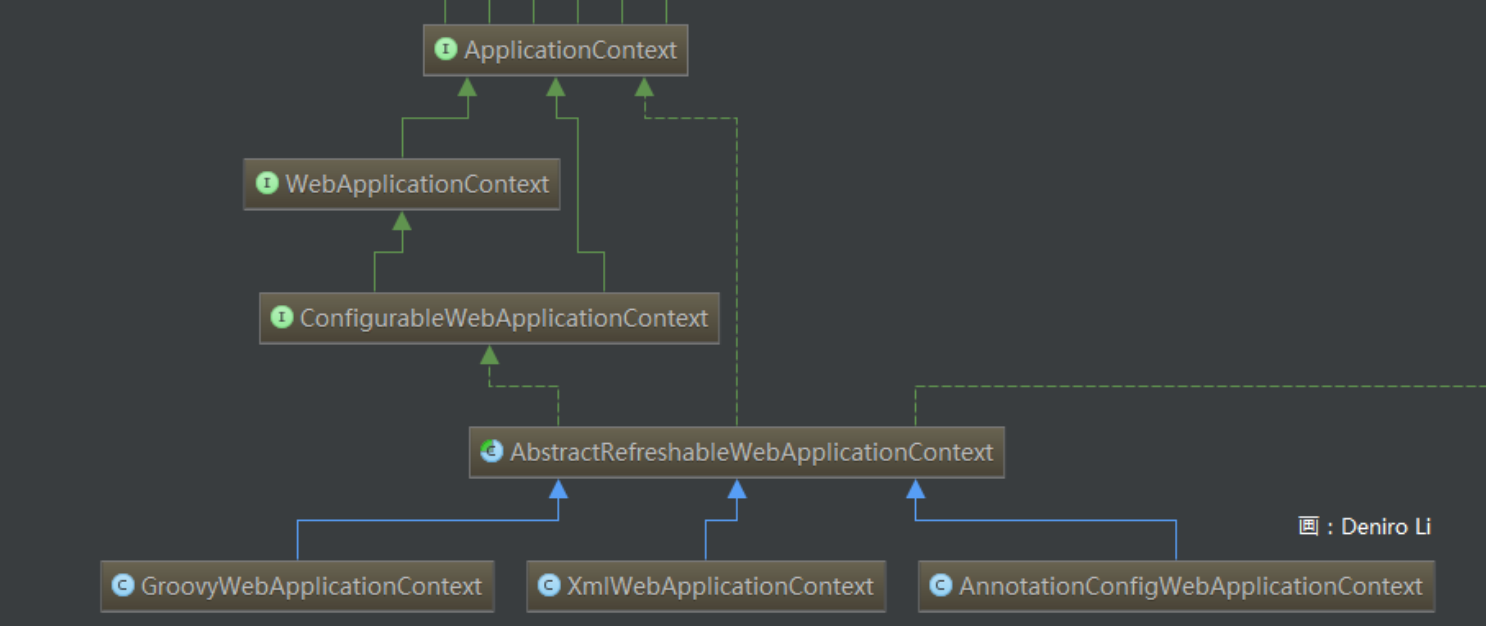
专门为web应用所准备,允许从相对于web根目录的路径中装载配置文件完成初始化工作。并且从WebApplicationContext中可以获得ServletContext(web容器上下文)的引用,整个web应用上下文对象将作为属性放置到ServletContext中,保证web应用环境可以访问Spring应用上下文。
ServletContext:javaee标准规定了,servlet容器需要在应用项目启动时,给应用项目初始化一个ServletContext作为公共环境容器存放公共信息。ServletContext中的信息都是由容器提供的。
在非web应用的环境下,bean只有singleton和prototype两种作用域。WebApplicationContext为bean添加三个新的作用域:request、session和global session。
WebApplicationContext可以通过WebApplicationContextUtils.getWebApplicationContext(ServletContext sc)获取。
WebApplicationContextUtils.getWebApplicationContext(ServletContext sc)
WebApplicationContext需要ServletContext实例,也就是说依赖于web容器,所以我们在web.xml中需要配置web容器监听器(ServletContextListener)。例如:
<?xml version="1.0" encoding="UTF-8"?> <web-app xmlns:xsi="http://www.w3.org/2001/XMLSchema-instance" xmlns="http://java.sun.com/xml/ns/javaee" xsi:schemaLocation="http://java.sun.com/xml/ns/javaee http://java.sun.com/xml/ns/javaee/web-app_3_0.xsd" version="3.0"> <!-- 指定 spring 配置文件--> <context-param> <param-name>contextConfigLocation</param-name> <param-value>classpath:applicationContext.xml</param-value> </context-param> <!-- web 容器监听器--> <listener> <listener-class>org.springframework.web.context.ContextLoaderListener</listener-class> </listener> </web-app>
ContextLoaderListener通过contextConfigLocation中配置的xml信息来获取Spring的相关信息。另外WebApplicationContext必须要使用日志功能,所以可以将log4j.properties文件配置在web.xml中,例如:
<!-- 指定 log4j 配置文件--> <context-param> <param-name>log4jConfigLocation</param-name> <param-value>/WEB-INF/log4j.properties</param-value> </context-param> <!-- Log4j 监听器--> <listener> <listener-class>org.springframework.web.util.Log4jConfigListener</listener-class> </listener>